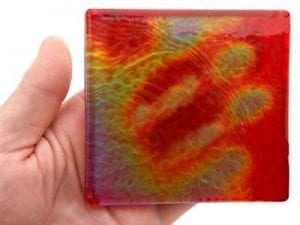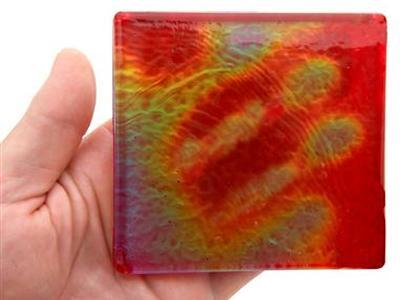Raise your hand, it’s ok to admit it, how many of you thought Thermochromic Polymer was an emo band you vaguely remember from your college days? A group of international scientists and researchers has developed a new temperature sensitive plastic dubbed Thermochromic Polymer. This polymer can change color in reaction to an increase or decrease in temperature and the color change happens almost instantly (I used to have a t-shirt that did this.) Originally thermochromic polymers were very limited by a small temperature range and were very slow to change back to their original color. Now the change is instantaneous and the color change can occur to temps up to 392°F. That is 200°C for any spambots, or Europeans, that are reading this blog post. I know how much spambots and Europeans love a dry sense of humor and a nice tidy metric measurement. Now if I could just get a tea cup made from this polydiacetylene polymer I would know when my spot of tea had cooled to just the right temperature. Polydiacetylene, say that 5 times fast. Ok now don’t you feel silly…who else heard you butcher that out loud?
I could tell you how the peptides stabilize the diacetylene is stabilized by Pepsi (or peptides, just seeing if your still listening, because I’m not) and the material is allowed to self-assemble (kind of like Robert Patrick in Terminator 2 but not really) into unbroken fibers and how the side chains vibrate due to a disturbance in the Force–heat (and all this time you thought the Force was some kind of unscientific new age pantheistic energy source, well wrong you would be.) Anyhoo the distinguishing of the wavelengths change the color of the polymer because the conjugation length changes (due to the heat/disturbance) and this disturbance occurs not in the Force but in the coplanarity of the polymer. The peptide acts as a stabilizing force (no, not that Force, fanboy) and focuses the disturbance until the polymer is removed from the source of heat, allowing the polymer to return to its original color instantly. The peptide remains stable up to 392°F beyond that it will loose the thermochromic ability, and possibly the ability to write heart-on-your-sleeve lyrics, descending from emo to a more gutteral, disillusioned socio-political punk band (depending on how much heat is applied.)
For a much less convoluted (i.e. boring) analysis of this new development go here. Hopefully, though I couldn’t put this in layman’s terms, you can visualize the process going on here and imagine with me new possible uses for this innovation in plastics. Will this one day replace the rectal thermometer for scarred mothers and fathers the world over? Could it be used in triage tape? Can we hope to find a way to use it in marshmallows to know when to pull them out just at the right time, golden brown on the outside and ooey-gooey on the inside right before they burst into flame and become a black, charred inedible mass with molten lava bomb innards. What about a car windshield (windscreen for the metric crowd) that reacts to light and heat to replace traditional window tint? What are your ideas and perceived uses of this new advancement in plastics? Share your ideas in the comments or connect with us on Facebook or Twitter. I will only take credit for the really good ideas, I promise.

